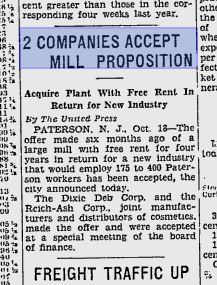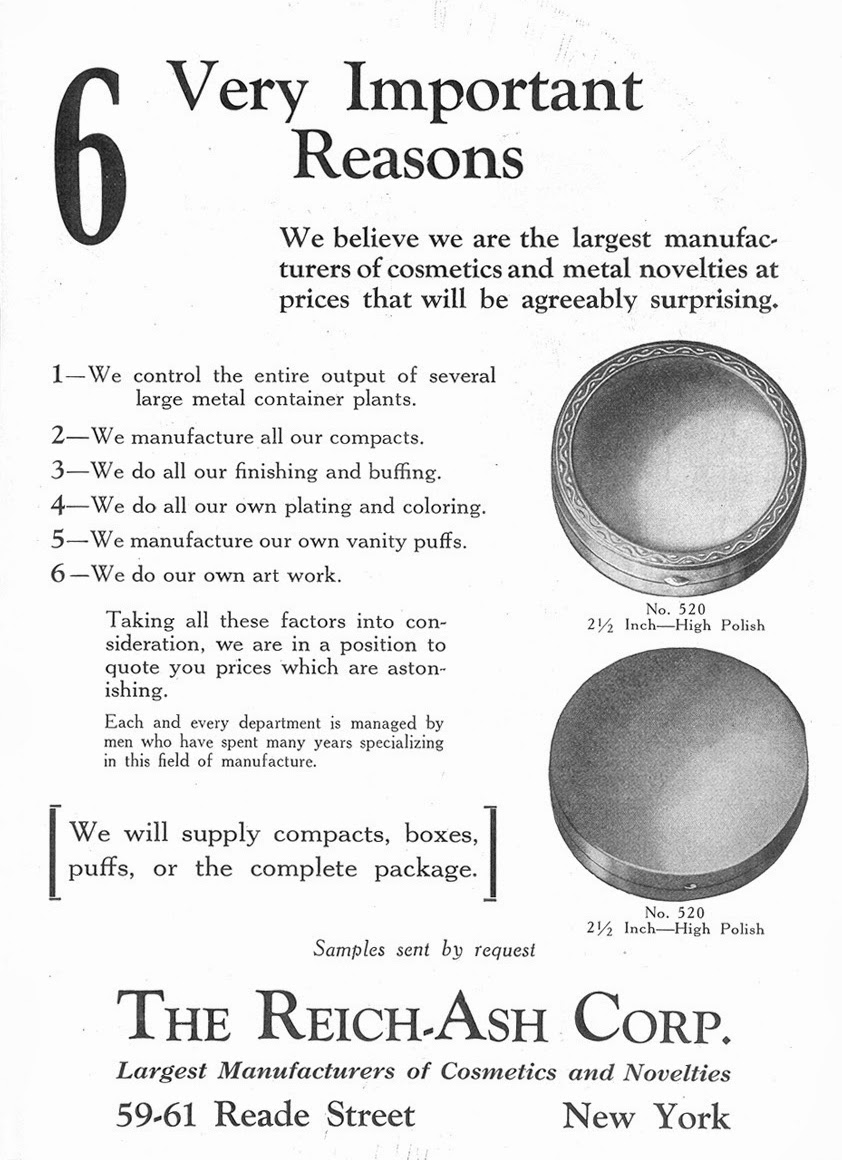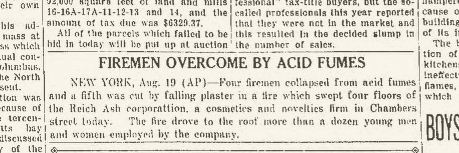#Illustrated #History #ReichAsh #Corp #Deere #Compact #Brand
.
In 1920 Leopold Reich entered into a partnership with Sidney Ash. Their company was styled as The Reich-Ash Corporation. Both men were experienced in the cosmetics industry. Ash had been employed by the Colgate Company and subsequently owned a business which we would describe as being involved in the cosmetics trade.
Reich and Ash manufactured compacts for compressed foundation powder and rouge.
The advertisement shown above gives a good indication of the products this business supplied. This advert dates to 1924. Their clients could be sure that Reich-Ash would supply all their needs regarding vanities because as well as manufacturing powder puffs, face powder and rouge the firm also had a large department which specialised in supplying custom artwork which included staff capable of high quality hand painted embellishment.
At this time manufacturers of toiletries made their profit from selling cosmetics rather than vanity cases. The manufacturers hoped that their eye-catching cases and compacts would entice customers to become repeat customers.

DEERE ROUGE
As well as manufacturing cases for other companies Reich-Ash marketed their own brand, which was named Deere. One of their earliest cases featured the head and chest of a stag (c.1920).
It may seem a little strange that a cosmetic company would opt to feature female nudes on products destined for the dressing tables or handbags of women but this is exactly what Reich-Ash decided to do. Perhaps their most famous vanity is the one shown below. Entirely nude and shown gazing at her own reflection this striking image depicts a bold confident woman at ease with her appearance.

This wonderful old gilded powder tin was made by The Reich-Ash Corporation c. 1921. The lid shows a nude lady gazing at her reflection in a hand mirror. She is surrounded by an elegant triangular frame with embossed flowers & foliage. This work is described as repoussage.
Repoussé or repoussage is a metalworking technique in which a malleable metal or precious metal is shaped by hammering from the reverse side to create a design in low relief.
Underneath her feet the tin is signed DEERE & another more subtle border of tiny raised circles which finishes the design of this famous antique powder tin nicely. The whole powder tin has a deep golden hue & has a granular appearance.
Care of this antique:
We have not attempted to clean this vanity because we feel it has a charm of its own.
The brass would probably polish to a high sheen but maybe some of the antique charm would be lost.
We feel as though antiques should be left uncleaned when ever possible.

DEERE SEMI-NUDE BRAND IMAGE
The image above was the registered trademark for The Reich-Ash Corporation.
The dotted lines which surround the seated lady became a design feature seen on some of their slipcases / tins.

REICH-ASH ROUGE POT
As well as mint green & cream colour scheme we have seen this design in red & cream and orange & cream.

COLOUR COORDINATED PUFF
The adorable pale green puff shown above compliments the green and cream enamelled lid.
The brand name is emblazoned across the puff sash in the same elegant font that we see on the registered trademark.

UNUSED ROUGE
The image above shows the original cover placed on top of the rouge. The container housing the rouge is made from card which is protected by the metal outer case.

ROUGE POT
The whole rouge pot can be lifted out of the rouge container.
These eye-catching vanities were designed to be refillable.

ANTIQUE REICH-ASH ROUGE
These containers are so durable that unused contents still look in good condition over one hundred years later, although it is not safe to use antique makeup.
Within a short period of time The Reich-Ash Corporation became a very successful enterprise. By the mid 1920s the company took up most of the floors of 59 Reade Street.
Sidney Ash bought out Leo Reich’s interests and became Reich-Ash’s majority stockholder with other family members involved in the business.
It is possible to find some of the compacts which are signed ASH’S DEERE BRAND.

Ash’s DEERE Brand a name value you cannot overlook ASH’S DEERE BRAND TAMPED on the back of every new Ash’s Deere STAMP Brand Compact is this identifying Trade Mark . ” Ash’s Deere Brand ” Cosmetics have been satisfying chain store …
1931 LISTING

ST. JOSEPH NEWS-PRESS 20 FEBRUARY 1931
REICH-ASH DOUBLE OR COTY SINGLE
Do you recognise this Coty brand compact?
The compact illustrated in this advertisement is the Coty New Compacte.

COTY NEW COMPACTE (RIGHT)
The Coty New Compacte was made by The Reich-Ash Corporation.
In 1931 this compact retailed for 49 cents.

ST JOSEPH NEWS PRESS 1931
This wonderful advertisement shows us that as well manufacturing their own brand Deere compacts, Reich-Ash made Coty and Tre-Jur compacts.
You’d be enthused over the savings!
They are the kind that accompany smart women everywhere.
Each completely filled.
The models are stunning.
Completely filled refers to Reich-Ash supplying the compacts with face powder and puffs.
Single and double most likely refer to whether the compacts were designed to hold either face powder or rouge or if they could accomodate both items of makeup.
On 19 August 1930 four floors of a Reich-Ash Corporation factory were engulfed in fire.
The injured included employees and firefighters. Four firemen collapsed from inhaling noxious fumes.
Some employees only escaped serious injury by fleeing onto the roof of the factory.
LOWELL SUN (LOCATION LOWELL, MASSACHUSETTS) AUG 19 1930

MIDDLE RIGHT MAIL ORDER REICH-ASH PRODUCTS
Reich Ash Bath Salts, fancy boxed…………….15c and 19c
Reich Ash Triple Compact extra special value …..95c
Sachets containing Reich-Ash cosmetics would often be printed with the following statement
The ingredients of this package are the purest and best obtainable and guaranteed by The Reich-Ash Corp. largest manufacturer of cosmetics and novelties.
NEW YORK PARIS

THE PITTSBURGH PRESS OCTOBER 18 1935
In the listing above we see The Dixie Deb Corp and the Reich-Ash Corp. described as joint manufacturers and distributors of cosmetics.
Deb probably is referring to the word debutante which was commonly used to describe young ladies making their debut on the scene of socialising etc.
These two companies made an offer to take on a large mill and engage up to 400 workers.
Part of the deal was that the mill would be rent free for a period of four years.

THE PITTSBURGH PRESS OCTOBER 18 1935
The front cover of The Pittsburgh Press gives an idea of the threat of fascism in Europe.
By September 1 1939 World War II had been declared.
The business is ceased to exist by the 1940s.
Whether or not all this turmoil had damaged this business we do not know.
More wonderful antique and vintage collectibles.
Sources:
Michael Hetherington’s compactblogspot
St. Joseph’s News-Press
The Pittsburgh Press





